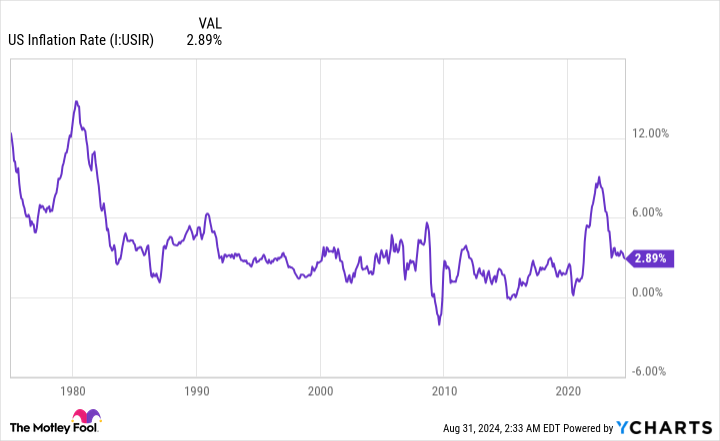For most retirees, Social Security is more than a check. It represents a necessary source of income that most retired-worker beneficiaries couldn’t live without.
Over the last 23 years, national pollster Gallup has been surveying seniors to determine how reliant they are on their Social Security benefit. At no point in this greater than two-decade stretch of annual polling has the percentage of retirees needing their Social Security income to make ends meet fallen below 80%. In 2024, 88% of retirees noted their Social Security benefit represents either a “major” or “minor” source of income.
Given the key role America’s top retirement program plays in laying a financial foundation for America’s aging workforce, it should come as no surprise that Social Security’s cost-of-living adjustment (COLA) reveal, which is slated for Oct. 10 at 8:30 a.m. ET, is the most-awaited announcement of the year.
As we’ve moved closer to this reveal, the 2025 COLA forecast has meaningfully narrowed, offering both promise and disappointment to beneficiaries.

What purpose does Social Security’s COLA hold?
Social Security’s often-talked-about COLA is the mechanism the Social Security Administration (SSA) uses to adjust benefits on a year-to-year basis to account for changes in the price of goods and services.
For example, if a broad basket of goods and services that are regularly purchased by seniors cumulatively increases in price by 2%, 3%, or 5%, Social Security benefits should ideally rise by a commensurate amount to ensure that no purchasing power is lost. The annual cost-of-living adjustment aims to keep the program’s beneficiaries on par with the inflation (i.e., rising prices) they’re contending with.
From the first mailed retired-worker benefit check in January 1940 through 1974, adjustments to benefits were completely arbitrary and passed along by special sessions of Congress. Following no COLAs during the entirety of the 1940s, 11 rather large adjustments were administered from 1950 through 1974.
Starting in 1975, the Consumer Price Index for Urban Wage Earners and Clerical Workers (CPI-W) was tasked with tracking inflation for Social Security and effectively became its inflationary tether responsible for determining the annual COLA. The CPI-W has more than a half-dozen major spending categories and a laundry list of subcategories, all of which have their own respective percentage weightings. It’s these weightings that allow the CPI-W to be expressed as a single, concise figure each month.
Most importantly, only trailing-12-month CPI-W readings from July through September factor into the COLA calculation. If the average third-quarter (July to September) CPI-W reading in the current year is higher than the average CPI-W reading during the comparable period last year, inflation has taken place and benefits will rise.
How much of an increase to expect is determined by the year-over-year percentage increase in average third-quarter CPI-W readings, rounded to the nearest tenth of a percent.
Social Security’s 2025 cost-of-living adjustment has substantially narrowed
Over the last 20 years, the average COLA has been a rather mediocre 2.6%. This period includes three years when deflation (falling prices) occurred and no COLA was passed along (2010, 2011, and 2016), as well as the smallest positive COLA on record (0.3% in 2017).
However, the last three years have somewhat broken this anemic COLA trend. The fastest uptick in the prevailing inflation rate in four decades led to a 5.9% COLA in 2022, 8.7% COLA in 2023, and 3.2% COLA in 2024. In particular, the 8.7% cost-of-living adjustment in 2023 was the highest on a percentage basis in 41 years.
With the July inflation report from the Bureau of Labor Statistics in the books, and the August inflation report due on Sept. 11, we’ve witnessed forecasts for the 2025 COLA narrow significantly.
The Senior Citizens League (TSCL), a nonpartisan senior advocacy group, began the year forecasting a paltry 2025 COLA of 1.4%. Following the July inflation report, this estimate has risen to 2.57%, which by definition would round up to 2.6%.
Meanwhile, independent Social Security and Medicare policy analyst Mary Johnson, who recently retired from TSCL, has had her 2025 COLA forecast drop from 3.2% following the April inflation report to 2.6% after the latest report.
Despite starting from opposite ends of the spectrum, TSCL and Johnson are now effectively in agreement that the 2025 cost-of-living adjustment will be 2.6%.
For the average Social Security beneficiary — i.e., nearly 68 million recipients — a 2.6% COLA would translate into an extra $46.35 per check, based on the average payout of $1,782.74 in July 2024. However, this increase in benefits can vary from person to person, as well as based on beneficiary type.
For retired workers, who account for more than 51 million of the program’s close to 68 million beneficiaries, a 2.6% COLA translates into an average monthly increase of $49.90.
By comparison, the average check for the roughly 7.2 million workers with disabilities and close to 5.8 million survivor beneficiaries would rise by $40.01 and $39.25, respectively, next year.


The 2025 COLA may make history and disappoint at the same time
Assuming TSCL’s and Johnson’s aligned forecasts are correct, a 2.6% cost-of-living adjustment would mark the smallest percentage increase in four years. While this might sound disappointing, it would still match the average COLA over the last 20 years.
More impressively, it would mark the first time since 1997 that Social Security’s COLA has reached at least 2.6% in four consecutive years. On a cumulative basis, benefits will have risen by almost 22% from the end of 2021, based on a 2.6% cost-of-living adjustment next year.
While it’s great on paper to see benefits rising at a faster pace than at any point in recent memory, there are also two disappointing realizations to be made about Social Security’s 2025 COLA.
To start with, a 2.6% COLA is likely to result in a loss of purchasing power for beneficiaries, which unfortunately has been a common occurrence since this century began.
TSCL has released two studies where they’ve compared cumulative COLAs over select time frames to the aggregate increase in price for a basket of goods and services regularly purchased by seniors. Between January 2000 and February 2023, it estimates the buying power of a Social Security dollar plummeted by 36%. In a separate study released in July 2024, TSCL found that the purchasing power of Social Security income has fallen 20% since 2010.
With two of the most important costs for seniors — shelter and medical care services — sporting trailing-12-month rates of inflation that are notably above 2.6%, a loss of buying power looks all but guaranteed.
The other disappointment comes in the form of Medicare Part B premiums rapidly rising for a second consecutive year. Part B is the segment of Medicare that covers outpatient services.
In May, the Medicare Trustees Report predicted monthly part B premiums would rise to $185 in 2025, which equates to a 5.9% increase. This matches the percentage bump experienced in 2024.
Most Social Security beneficiaries who are enrolled in Medicare have their Part B premiums automatically deducted from their monthly benefit. In other words, a second consecutive year without a silver lining from Medicare Part B will minimize the impact of Social Security’s upcoming COLA.
Next year is looking like one of those rare instances where history is made, but disappointment looms large.
The $22,924 Social Security bonus most retirees completely overlook
If you’re like most Americans, you’re a few years (or more) behind on your retirement savings. But a handful of little-known “Social Security secrets” could help ensure a boost in your retirement income. For example: one easy trick could pay you as much as $22,924 more… each year! Once you learn how to maximize your Social Security benefits, we think you could retire confidently with the peace of mind we’re all after. Simply click here to discover how to learn more about these strategies.
View the “Social Security secrets” »
The Motley Fool has a disclosure policy.
Social Security’s 2025 Cost-of-Living Adjustment (COLA) Has Narrowed — Here’s How Much the Average Check Is Forecast to Rise Next Year was originally published by The Motley Fool

